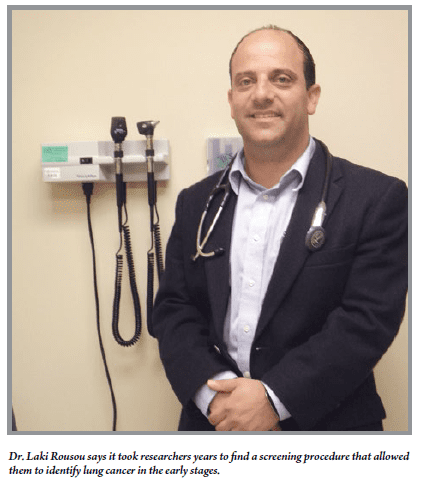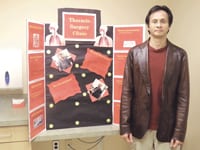Breathing Easy New Screening Can Detect Lung Cancer in Early Stages
Lung cancer is a dreaded disease. “It’s the most deadly cancer in this country; approximately 225,000 new cases are diagnosed every year, and 160,000 people die from it in that same time period,” said Dr. Laki Rousou, a thoracic surgeon at Mercy Medical Center. “Lung cancer constitutes 27{06cf2b9696b159f874511d23dbc893eb1ac83014175ed30550cfff22781411e5} of all cancer deaths, but in the past 30 years, we haven’t made a dent in the survival rate or prognosis, despite the decrease in smoking.”
The reason is twofold: there was never an effective screening test for the disease, and people typically don’t have any symptoms until the end stages, so it is usually discovered in stage 3 or stage 4.
But that is about to change, thanks to the discovery that a spiral CT scan, which is performed more quickly and results in less exposure to radiation than a regular CT scan, can detect the disease in the early stages. Medicare approved the test about seven months ago for individuals at high risk for the disease, and other insurance agencies have followed suit, which could save thousands of lives each year.
Dr. Neal Chuang says the screening is critical, due to the lack of symptoms.
“It’s an aggressive cancer, but most people don’t feel anything during the early stages,” noted the chief of Thoracic Surgery at Mercy Medical Center, adding that, when the cancer is advanced, the three most common symptoms are cough, shortness of breath, and chest pain, but since a cough is a general symptom and many smokers cough, they don’t seek help for the problem until it is too late.
Rousou concurred and added that pain doesn’t usually occur until the disease has invaded the ribs or the chest wall, and although weight loss and fatigue are also typical in the late stages, these symptoms are associated with a wide number of other conditions. “If lung cancer is diagnosed early, it’s usually because it is found incidentally when someone has a chest X-ray or a CT scan for another reason,” he told HCN. “There have been vast improvements and outcomes in the past 30 years for colon, breast, and prostate cancer due to screening tests, but until recently no one was able to find a screening for lung cancer that was effective.”
The majority of people diagnosed with the disease are over 65 and have a long history of smoking. “Cancer is typically caused by a combination of genetic changes that occur within a cell. But the changes don’t occur simultaneously. They can start when a person is smoking, but it could be 10 years before more changes occur. But the longer and more you have smoked, the more likely you are to develop lung cancer,” said Dr. Sean Mullally, a medical oncologist/hematologist and medical director of the Mass General Cancer Center at Cooley Dickinson Hospital.

Rousou concurred. “The screening is a very exciting development because lung cancer is a curable disease if it’s found in the early stages. The five-year survival rate today is only about 10{06cf2b9696b159f874511d23dbc893eb1ac83014175ed30550cfff22781411e5} to 16{06cf2b9696b159f874511d23dbc893eb1ac83014175ed30550cfff22781411e5}, but the survival rate with early detection and treatment rises to 60{06cf2b9696b159f874511d23dbc893eb1ac83014175ed30550cfff22781411e5} to 80{06cf2b9696b159f874511d23dbc893eb1ac83014175ed30550cfff22781411e5},” he said, adding that the potential of this screening surpasses other tests that have become standard care.
“If 320 people at high risk for lung cancer are screened, one life can be saved. By comparison, 800 people need to have a colonoscopy to save one life, and 900 to 1,900 need to have a mammography, which makes the lung-cancer screening more effective than other tests.”
Although the majority of cases are attributed to heavy smoking, the American Cancer Institute says exposure to a variety of substances can also increase the risk of developing the disease. They include:
• Marijuana. Smoking one marijuana joint equates to smoking an entire pack of cigarettes in terms of the potential effect on the lungs;
• Exposure to chemicals, including arsenic and asbestos;
• Exposure to radiation in the workplace, from medical tests, or from the environment;
• Exposure to radon gas in the home or workplace;
• Air pollution. Studies show that people who live in areas where the air is very polluted have an increased risk for the disease; and
Gene changes or mutations, which typically occur as a person ages.
“We do see a percentage of people who have never smoked, but the biggest risk factor is still smoking,” Rousou said. “Any smoking history increases your risk of developing lung cancer.
Significant Advances
Rousou said researchers spent years trying to come up with an effective screening tool.
“They tried doing chest X-rays on smokers in a certain age group, but found it didn’t help. Then, they looked at sputum, then combined sputum with chest X-rays. But that didn’t make a difference,” he noted.
Finally, in 2002, researchers switched their focus, and more than 53,000 current or past heavy smokers were screened either with a low-dose CT scan or a chest X-ray in a test called the National Lung Screening Trial.
“There was a 70{06cf2b9696b159f874511d23dbc893eb1ac83014175ed30550cfff22781411e5} increase in the number of detected cases of stage 1 and stage 2 cancer in the group that had the CT scans, and 20{06cf2b9696b159f874511d23dbc893eb1ac83014175ed30550cfff22781411e5} fewer deaths,” Rousou said, adding that the results were released in 2010.
Three years ago, the findings led the American Assoc. for Thoracic Surgery to recommend that people at high risk for the disease have the screening. The American College of Chest Physicians followed suit in 2013, and was joined by the U.S. Preventative Services Task Force.
The matter was presented to Congress, and about seven months ago, the Center for Medicare and Medicaid Services announced it would cover the cost of low-dose CT scans for people between the ages of 55 and 77 who meet specific criteria: they must smoke, or have quit within the last 15 years, and have a smoking history of 30 pack-years. That equates to having smoked a pack a day for 30 years or two packs a day for 15 years, for example.
They must also not have any signs or symptoms that lung cancer is present, and it is advised that they attend a smoking-cessation program or get counseling on the importance of continued smoking cessation.
In addition to the new screening, advances have also been made in surgical techniques and the impact of treatment on patients with stage 1 lung cancer. Today, Rousou explained, three to four one-half-inch incisions are used to remove the tumor, and people need to be hospitalized only three to four days. “That’s all that is needed.”
If the cancer has reached stage 2, surgery is typically followed by chemotherapy, while a combination of chemotherapy and radiation (and surgery in some cases) is used to treat stage 3. Although some people think that there is no need to treat individuals with stage-4 lung cancer, Chaung said that is a false assumption.
“It can prolong survival and prevent complications, such as pain,” he said.
Mullally added that chemotherapy is much more effective than it was in the past and has less toxicity. “The list of treatment options is growing year by year.”
One is an exciting new development for people with advanced cancer that can slow its progression and make it shrink or even temporarily disappear. “We have discovered about 5{06cf2b9696b159f874511d23dbc893eb1ac83014175ed30550cfff22781411e5} to 10{06cf2b9696b159f874511d23dbc893eb1ac83014175ed30550cfff22781411e5} of people have molecular changes within the cancer itself that make them susceptible to targeted treatments,” Mullally said, adding that the therapy was approved in 2011 and is administered in pill form, and patients with the appropriate genetic mutations are identified when the biopsy is sent to a central processing lab. “The new therapy has been very gratifying.”
One of Mullally’s patients whose cancer had the molecular changes that can respond to the targeted therapy was treated after her cancer advanced into her bones and brain.
“Six weeks after she began the therapy, the majority of the disease was gone. However, it did return in one lesion of her brain 10 months later,” he told HCN, but added that the area will be treated with radiation, she will continue on the therapy, and is likely to live another two to three years. “Six years ago, she probably wouldn’t have lived more than a few months.”
Chuang said the targeted treatment can be used for two different types of mutations, and if people respond to it, it can hold their cancer at bay for years. “It’s important because lung cancer tends to be aggressive. It’s also what makes the new screening so exciting because it gives us an opportunity to diagnose the disease when it is more curable.”
But specialists say it’s important for people to understand the risks associated with the screening, and hope primary-care physicians will refer patients to them who qualify for the test, rather than simply ordering it.
They feel it’s necessary, Chuang explained, because not only can they can inform patients about what to expect, they also explain the results of the test and what they mean, as a follow-up visit is typically scheduled. Risks include the fact that testing could show a suspicious spot in the lung that could result in the person having a biopsy or a needle aspiration or a different procedure that can be benign.
He added that Mercy Medical Center is also trying to maintain a database with results from screenings.
Hope for the Future
The medical community is optimistic that additional targeted therapies will emerge in the future.
“In 2006, the average survival rate for a person with advanced lung cancer was 11 months; now it’s two and a half years, and chemotherapy is much more tolerable,” Mullally said. “But the only real chance of a cure is when it’s detected early and removed surgically. Once it has advanced, it’s still a terminal disease.”
He knows people are busy and some fear they will find out they have lung cancer if they are tested. “But catching it early gives you the best chance for a cure. It’s so much better than other scenario, and if you meet the criteria for the screening, I suggest you have it done.” v


